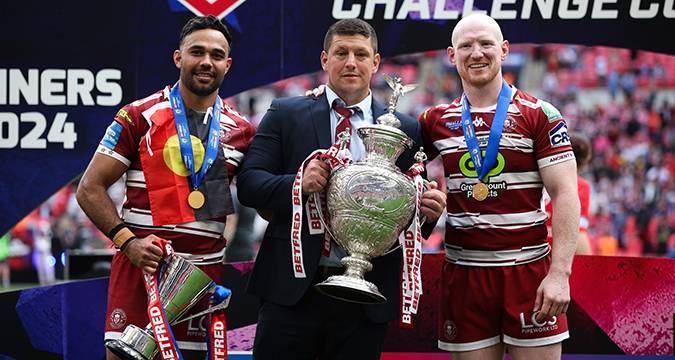
The Challenge Cup will have a new structure in 2025 – but what difference will it make?
FAIR play to the RFL, who are not always the quickest to react when something needs to be done.
But this year’s Challenge Cup was such a depressing affair that the game’s rulers had little other choice.
We wrote only three issues ago (‘Cup Half Empty’, RLW 496) of the serious problems with the competition, once seen as the pinnacle of rugby league but now struggling to draw the interest of fans.
In an attempt to change that, from next season the Challenge Cup will have a new structure, the headline change being that Super League clubs will enter at the last-32 stage instead of last-16, and all play their first ties away from home.
More broadly, there has been a welcome streamlining of what were previously dragged-out early rounds and all-too-quick latter stages. The number of rounds has been reduced from nine to seven, although the number of participating clubs has actually marginally increased from 64 to 68.
Sixteen first-round winners (from 32 community clubs starting out) and the 24 clubs from the Championship and League One will not only go into the hat for round two, but round three at the same time so they know if their reward for victory will be a Super League visitor.
Compared to at present, when top-flight sides only enter when four other teams are left, it’s undoubtedly an improvement. And an achievement, too – persuading Super League clubs, usually concerned only with self-interest, to offer themselves up for another weekend.
If not quite a return to all clubs going in the hat from round one, just a little of the old magic has been restored. But what about the new issues that have undermined this most famous of cups?
Our analysis three months ago found the Challenge Cup’s single-biggest problem was predictability. Since Super League became fully professional, the gulf in standards has grown to the extent that ‘cup shocks’ are as rare as prop-forward hat-tricks. Fans want to see at least a semblance of jeopardy and the competition can no longer provide that.
It seems the stipulation that Super League clubs must be drawn away from home is an attempt to inject that jeopardy – but it is unlikely to do so. As a result, it is also unlikely to bring sell-out crowds to the lower-league grounds the game left behind – although any increase and fleeting profile boost is welcome.
Look beneath the surface and it may not be such a well-meaning move at all, rather one of self-interest. It means the Super League clubs are all kept apart in that round, with no risk of knocking each other out. In turn, for clubs below the top-flight a proper cup run, to the quarters or beyond, remains a pipe dream.
Speaking of the latter stages, will the new structure do anything to raise their profile, after two poorly-attended semi-finals and 25,000 unsold Wembley seats? In short, no – from the last-16 onwards, the competition will look and feel exactly the same.
One of the most disastrous elements of this year’s competition was the BBC only broadcasting games on TV from the quarter-finals onwards. When all top-flight teams last entered in a round of 32, in 2014, the BBC covered games from that point – two rounds earlier than now.
But with the current TV deal also agreed for the next two years, the scarcity of coverage will probably continue – further depriving the Challenge Cup of publicity, and momentum towards Wembley. Ironically, it’s a victim of the BBC’s deal to screen league matches – just another example of the Cup’s decline at the (relative) power of Super League.
Meanwhile, one of the last remaining benefits of football’s FA Cup is its transformational potential, in financial terms, for lower-league teams. That simply is not the case in rugby league, where the Cup has become a cost rather than a profit due to the paltry prize money the RFL can offer. A Super League visitor in round three will bring a moderate boost on the gate, and that is to be celebrated, but this restructure will do nothing more for the Challenge Cup’s wider financial health.
Three months ago, our feature on the competition concluded: “You can tweak the format – ensuring clubs from different divisions play each other more is the most obvious one, considering that is the competition’s USP – but ultimately you cannot overcome all of the wider problems.
“Instead the question should not be how to revive the Challenge Cup to past glories, but how to develop other events that are fit for the future.”
This new format is that tweak, and is undoubtedly an improvement on the structure of the last few seasons, but that conclusion still holds true.
—
Meanwhile, if the men’s Challenge Cup has a problem with predictability, take a look at the Women’s Challenge Cup!
With three/four clubs miles ahead of the rest, that competition tends to only start with any seriousness in the semi-finals – albeit those big three matches are of strong quality.
After two campaigns of a 16-team group stage leading into quarter-finals, the RFL say discussions are ongoing over the women’s structure for next season.
The same is true of the Wheelchair Challenge Cup, which returned to a knockout format, of eight teams, in 2024 and delivered some strong matches.
That said, invited club Catalans blasted all English opposition, won the final at a canter, and as a result the RFL’s silver is being kept in France for another twelve months.
Who said there is ever an easy answer?
First published in Rugby League World magazine, Issue 499 (August 2024)
Click here to subscribe to the print edition of Rugby League World
